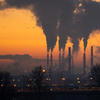You are here
The Earth, precariously balanced

With ever-increasing concentrations of greenhouse gases in the atmosphere, soil and water pollution, and declining biodiversity, the Earth system is more than ever under threat from human activity. As well as climate deregulation, the state of other subsystems such as the biosphere, the cryosphere, and atmospheric and oceanic circulation is also deteriorating.
On the scale of a human lifetime, such changes are not always noticeable, but from a geological point of view, all this is taking place in the blink of an eye. A rapid transition from a so-called normal state to another, degraded situation is known as a tipping point.
The concept of a tipping point in the Earth system first emerged in the early 2000s, when scientists modelled the behaviour of the Atlantic circulation, the Amazon rainforest and the Greenland ice sheet under conditions that would lead to their instability or even degradation. "The idea is that when stress increases in a system, nothing much happens until a certain point is reached at which that system spirals out of control and switches to another state," says Sonia Kéfi, research professor at the Institute of Evolutionary Science of Montpellier (ISEM)1 and co-author of the Global Tipping Points report published in December 2023 on the occasion of COP28.
The report, which was coordinated by the Global Systems Institute at the University of Exeter (UK) and involved many researchers from around the world, reviews identified Earth system tipping points, and warns of the consequences if they are crossed. “We wanted to draw attention to the fact that scientists now know that some systems can change very rapidly and sometimes irreversibly,” explains Vasilis Dakos, a researcher in ecology at the ISEM and co-author of the study.
Trapped in a new state
Published last December, the report lists twenty-five tipping points identified in the Earth system: six in the cryosphere (for instance the melting of permafrost – permanently frozen soils – and of the Antarctic and Greenland ice sheets); sixteen in the biosphere (such as the eutrophication of lakes and the disappearance of coral); and four in atmospheric and oceanic circulation (including the West African monsoon and the Atlantic Meridional Overturning Circulation, AMOC). But as Dakos points out, "Every lake or forest may have its own watershed, and each one may be different. There’s therefore a huge number of them on local scales, some of which may already have been reached." The notion of a tipping point can be shown using a bifurcation diagram, which represents the state of a system as a function of the stress to which it is subjected. Ecological and climate patterns are considered to be healthy or degraded, based on a number of variables. Various factors can be regarded as a source of stress, such as the ambient temperature, the extent of deforestation, the humidity of the atmosphere, the amount of fresh water, and so on.

Above a certain level of pressure, the system can no longer maintain its initial state and shifts towards a degraded one, into which it settles in a relatively stable manner. "The dynamics inherent to this new condition mean that you are trapped in it, as it were," Dakos explains. In ecology, the ability of an environment to stabilise after being disturbed is called hysteresis. To reverse this process, it would theoretically be necessary to reduce the factor(s) that led to the tipping point.
"However, in many well-known examples, there is a whole range of values where, no matter how much you reduce the levels of stress, the system doesn't return to its original condition," Kéfi points out. "For it to have a chance of recovering, you would need to go much further back in time before the pivotal moment," Dakos confirms. In other words, for the same amount of pressure, both healthy and degraded states are possible, but feedback loops reinforce the tendency of the system to remain in whatever situation it is currently in.
As the two scientists point out, reducing the level of stress is therefore not always possible. For example, capturing CO2 directly from the atmosphere is extremely hard to achieve at the present time. All that can be done is to stop emitting it before the tipping point is reached. In fact, the irreversibility of the change depends on the scale: it is easier to lessen negative factors acting on a single lake than on a system extending over several oceans.
Accumulating stress factors in the Amazon rainforest
In addition, several types of pressure can impact the same system, combining and strengthening their effects. Take the Amazon rainforest for instance. In its stable state, it creates its own hydrological cycle by producing clouds and rainfall by means of a loop of evaporation and precipitation, thus reducing its seasonality. Climate change could lead to less rainfall in the Amazon, causing some of the trees to die, which would lower the amount of water vapour released into the region. This would further increase drought and kill more trees, plunging the area into a vicious circle. Furthermore, a rise in the number of wildfires would result in a massive release of CO2 into the atmosphere, further exacerbating global warming.

However, changing rainfall patterns are not the only threat to the Amazon rainforest. Human-induced deforestation has been shown to aggravate the vulnerability of this system, leading to a further reduction in evaporation. In the long term, the rainforest could turn into a savannah, which would be disastrous for biodiversity, cause enormous social and economic damage to that part of the world, and in addition deprive the planet of a major carbon sink. Not to mention the fact that a decline in evapotranspiration from the Amazon rainforest could also affect weather patterns around the globe.
Cascading tipping points
As well as bringing about a combination of various stress factors acting on the same environment, the consequences of a degradation in the state of one system can cause or increase pressure in another. "The entire Earth system can be thought of as a vast network of interconnected elements. So, it's clear that there must be cascades of tipping points: for instance, when part of the biosphere collapses on a large enough scale, this affects the climate, and vice versa. And since human activities also depend on ecosystems, this in turn impacts the economic, social and political spheres," Kéfi explains.
Crossing one or more global tipping points would be damaging to our societies on several levels, such as food, health, and housing. However, the report also draws attention to the fact that the same dynamics of watersheds exist within our societies and that they can be used to speed up positive social transformations. This can be achieved through technological innovation, financial investment, and political and social action, but most importantly through changes in behaviour.
The concept of social tipping points was introduced in the 1960s by Morton Grodzins, a professor of political science at the University of Chicago (US), to describe how in the United States white families living in predominantly white neighbourhoods stayed there as long as the number of black families remained low. And how, once a certain proportion of black households had settled in, white ones began to leave the area in droves – a sign that, according to Grodzins, a social tipping point had been crossed. More recently, regulations and social norms regarding smoking have also undergone a major shift. "For decades, smoking in public places was considered completely normal, even though it was known that the habit was harmful, until a Europe-wide decision banned smoking indoors. This led to a dramatic change in attitudes in a very short time. Today no one would dare light a cigarette in a restaurant," Kéfi points out.
Bringing about rapid shifts in social attitudes
A number of studies, summarised in the report, show that if a fraction of a population (between 3.5% and 10%) rallies around a common goal long enough to exceed a critical threshold, then the dominant social structure can be transformed, especially through changes in legislation and the emergence of new norms.
The document also shows that some social tipping points have already been reached in the battle against global warming. This is especially true with regard to wind power and photovoltaics. Investment in research has made it possible to optimise these energy production systems and make them cheaper, enabling them to be deployed on a large scale. The same is true for electric cars, sales of which have soared in many countries.
According to scientists who have studied the market share of electric vehicles, the tipping point has already been crossed in Europe and Asia but has not yet been reached in the US.
As Dakos points out, "within human societies, there are mechanisms such as the economy, political choices and lobbies, that can determine the direction a process takes". This is the subject of the last part of the report, which analyses the measures that can be implemented in economic and social systems to stimulate changes in thinking and behaviour that are consistent with a sustainable future for humanity. As the survey states, "We are now so close to Earth system tipping points that positive tipping points to accelerate social change are the only realistic systemic risk governance option." ♦
Reference
The Global Tipping Points Report, December 2023.
- 1. CNRS / IRD / Université de Montpellier.





















